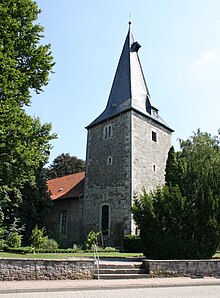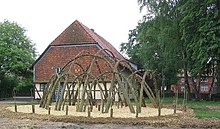Marienkirche (Wendeburg)
The Marienkirche is a church in the middle of the district Wendeburg of the municipality Wendeburg in the district of Peine , whose municipality belongs to the provost of Vechelde in the Evangelical Lutheran Church in Braunschweig .
Historical classification
At the point where the old military road from Braunschweig to Celle crossed the Aue (river through Wendeburg ), a small fortified castle "Winetheborg" was founded in the Middle Ages (12th or 13th century) . The former castle chapel is the forerunner of today's Marienkirche. Get out of the Middle Ages is only a consecration panel that in about five meters at the church tower is attached and is reminiscent of the New consecration of the church for greater conversion. This stone shows the crucified with Mary and John , at their feet the praying donor couple (?). Below is her noble coat of arms with the year 1439.
From the age of the Reformation (16th century) there are written reports about the church and its pastors. The first pastor mentioned is a Heinrich Meyer-Arndes. Lange (1545–1590) was ordained as a priest in Hildesheim. In the maelstrom of the Reformation struggles, he had to change his denomination several times: the exact theological differences between Protestant and Catholic were probably not exactly known to him. When he died, the congregation had officially become Protestant - but the disputes were far from settled. His successor, Pastor Gebhardi, was killed by Catholic troops (Spaniards) right at the beginning of the Thirty Years War . And in return, the Protestants attacked the Catholic priest of Woltorf, Friedrich Spee, who is also known as a poet, and injured him critically. The religious battles lasted around a hundred years (from around 1540 to 1640). Churchism and probably also the Christian faith had sunk a lot during this time; Services were rarely attended.
At that time, superstition took the place of faith ; In 1676 a certain Anna Voigt was arrested in Wendeburg , taken to Wolfenbüttel and charged with her “ witchcraft and sorcery ” (unfortunately we do not hear about the outcome of the trial).
While the rest of the Braunschweig region remained un-ecclesiastical, development in Wendeburg took a slightly different path. We owe this in part to two pastors who worked together as clergy for almost 100 years: Pastor Christian Schmidt (1625–1672) and his son-in-law Pastor Sebastian Marburg (1672–1721). Through them, church life slowly stabilized again. In 1650 a large Bible was bought, which is still in the community's possession today, as well as Christian Ludewig Meyer's big bell in 1714 , which is still there today. In 1753, the duties of the Wendeburg pastors expanded: They became a kind of school supervisory officer for all the surrounding village schools. The Wendeburg rectory became the seat of an "inspection" and the Wendeburg pastors were allowed to call themselves " Superintendent " until 1877 .
The church became too small for the increased population of Wendeburg , Wendezelle and Zweidorf . In 1770 the nave was therefore lengthened and raised. At the beginning of the 19th century, the old rectory had also become too small and an extension or expansion was not profitable. Today's parsonage (1827) was built under Pastor Schönermarck, along with the associated stables, today's parish hall. Pastors Wilhelm and Paul Beste are particularly well known. Wilhelm Beste - later Superintendent General of Braunschweig and holder of many high honors - was pastor and superintendent in Wendeburg from 1859 to 1868. His son Paul Beste worked in the congregation from 1886 to 1892. Both wrote many theological books and tracts . On April 15, 1890, Konrad Beste saw the light of day in the Wendeburg rectory . After the First World War he became very popular as a poet and writer, whose numerous novels achieved high numbers of copies and whose dramas were performed on many stages in Germany. He died in December 1958.
A new era then dawned with Pastor Hayder, who served in Wendeburg for more than three decades from 1892 to 1923. The places had become relatively wealthy through the cultivation of sugar beet and asparagus. And the bus connection to Braunschweig set up on Hayder's initiative (the world's first power post bus line from 1904) ensured that the money could soon be spent. On his initiative, the Raiffeisenkasse was founded before the First World War , the “Frauenhülfe” (an institution that at that time roughly corresponded to our current social station) and the kindergarten. For three decades, which were not only politically very moving, namely from 1929 to 1959, Carl Schlüter (d. 1947) and his son Hans were pastors in Wendeburg. The shocks that the so-called Third Reich brought with it also in the spiritual field could also be felt in Wendeburg: church resignations, youth consecrations and weddings "under the banner" were carried out.
When Pastor Edmund Thies took over the pastor's office in 1959, the situation had largely normalized. A steel bell was purchased in 1952 for the bell that was pulled in and destroyed in 1942, and the kindergarten barrack built in 1937 was replaced by a real building in the parish garden in 1958.
In 1963 the church was completely redesigned: the priechen (built in 1770) were removed, the (hard) pews were replaced by more comfortable ones and a new organ was installed.
During the term of office of Pastor Otto Pfingsten, from 1977 to 2008, based on an idea by Marcel Kalberers , volunteer young and old people built a willow church and a Bible garden between February 2006 and May 2006 .
The bell of the church consists of the peace bell (steel, 1952, dis), the Christ bell (bronze, 1714, f sharp) and the family bell (bronze, 1989, a sharp).
Pastors of the church
| 1551-1597 | Heinrich Meyerarndes |
| 1597-1626 | Andreas Gebhardi |
| 1627-1628 | Joachim Hilbrecht |
| 1628-1672 | Christian Schmidt (Fabricius) |
| 1672-1721 | Sebastian Marburg |
| 1721-1730 | Georg Oberfeldt |
| 1731-1746 | Friedrich Lincke |
| 1746-1760 | Friedrich Koch |
| 1761-1773 | Brandam turner |
| 1773-1788 | Benjamin Horn |
| 1789-1794 | Johann Koch |
| 1795-1823 | Carl Horn |
| 1824-1834 | Friedrich Schönermarck |
| 1834-1842 | Georg Liege |
| 1843-1858 | Theodor Krebs |
| 1859-1868 | Wilhelm Best |
| 1868-1877 | Christian Oberhey |
| 1877-1886 | Theodor Klusmeyer |
| 1886-1892 | Paul Beste |
| 1892-1923 | Otto Hayder |
| 1923-1929 | Hermann Hägerbäumer |
| 1929-1947 | Carl Schlueter |
| 1947-1959 | Hans Schlueter |
| 1959-1977 | Edmund Thies |
| 1977-2008 | Otto Pentecost |
| 2008-2009 | Pastoral position not occupied |
| Since 2009 | Frank and Petra Wesemann |
literature
- Otto Pfingsten and Rolf Ahlers: The Wendeburg Church . 1st edition. Uwe Krebs, Wendeburg 1990, ISBN 3-9802525-0-7 .
- Otto Pfingsten: Pastor Karl Schlueter - The Wendeburg pastor in the Third Reich . 1st edition. Uwe Krebs, Wendeburg 1997, ISBN 978-3-932030-02-4 .
- Otto Pfingsten: Andreas Gebhardi in the Thirty Years' War - The fate of the first Protestant pastor in Wendeburg . 1st edition. Uwe Krebs, Wendeburg 1997, ISBN 978-3-932030-04-8 .
- Rolf Ahlers: The rectory in Wendeburg . 1st edition. Uwe Krebs, Wendeburg 2002, ISBN 978-3-932030-20-8 .
- Otto Pfingsten and Rolf Ahlers: The Marienkirche in Wendeburg . 1st edition. Uwe Krebs, Wendeburg 2004, ISBN 3-932030-27-3 .
swell
- Archive of the Wendeburg community
- Archive of the parish of Wendeburg
- Archives of the Regional Church of Braunschweig, Wolfenbüttel
Web links
Coordinates: 52 ° 19 ′ 37.6 ″ N , 10 ° 23 ′ 41.9 ″ E



